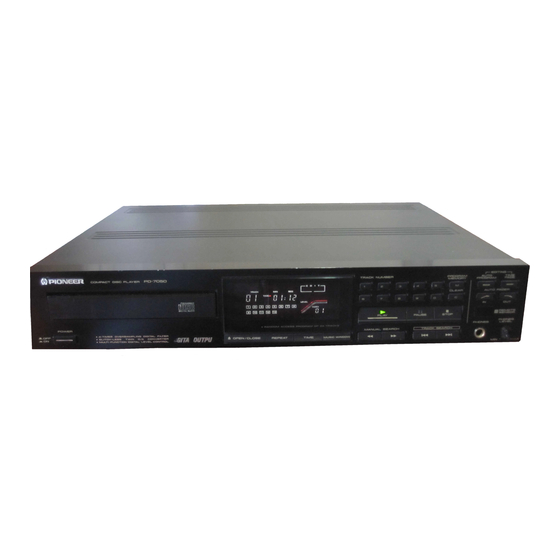Pioneer PD-6050 Manuale di servizio - Pagina 9
Sfoglia online o scarica il pdf Manuale di servizio per Lettore CD Pioneer PD-6050. Pioneer PD-6050 31.

(5) Resin body
The CD body has been made with computer-simulated
technology. To keep body changes to a minimum, resin has
been incorporated. Due to the mounting, materials were
carefully selected and the same reliability as the previously-
used aluminum has been realized.
The use of resin has made possible mounting configurations
that were not possible with aluminum. Therefore the use of
adhesives has been greatly reduced for improved reliability.
2-3 RF and servo signal
Fig. 2-3
(2) RF and servo signals
The beam, which has been reduced to an extremely
small spot by the objective lens, now strikes the disc side
on which the signal is. located. Part of the beam is then
reflected back to the objective lens and photo diode. A di-
agram showing how this beam is reflected off the disc is
shown in figure 2-2. (A) shows what happens when the con-
centrated beam is directed at a pit. Normally, this reflected
light would disrupt the output light beam. In the laser diodes
used in CD players, however, noise is reduced instead, result-
ing in stable performance. This property is very advantageous
for.the half prism which allows only half of the light energy
to pass.
A pit and (B) shows the same beam when reflected from
a space between pits. In case (A), the beam is diffracted, so
the dark part of the beam does not return to the objective
lens. Instead, only the center of the beam passes through the
objective lens and reaches the photo diode. In case (B), there
is no diffraction because the beam does not strike a pit. There-
fore, the entire beam is reflected back to the photo diode,
producing brighter beam than when a pit is reached. In this
system, the data on the disc, which is represented by pits,
is covered into an electrical signal at the photo diode accord-
ing to the intensity (brightness) of the reflected^beam. The
RF signal is then produced from this electrical signal by the
computation circuit.
Fig. 2-3 shows how the focus signal is detected. (1) is
when the beam from the laser diode is accurately focused on
the disc by the objective lens. (2)shows what happens when
the disc comes closer to the pickup and (3) shows what hap-
pens when the disc moves farther away. The grating and con-
cave lens, which have no direct effect on the focusing are not
shown in the diagram.
In case (1), the beam emanating from point 01 is reflect-
ed and diffracted on the disc surface to produce the con-
densed beam (02). In case (2), the beam is directed at a
point farther than that of beam 02. Fig. 2-4 shows the
properties of the half mirror. 1 through 7 shows the shape
of the beam at each point. Between points 2 and 6, which
are in a straight line, the beam is circular at point 4. Point 6
corresponds to beam 02 of fig. 2-3. If we assume that fig.
2 4 shows mode (1) of fig. 2-3, that means the beam is cir-
cular because the photo diode is located at point 4. In
mode (2) of fig. 2-3, the location of the photo diode is
closer to the cylindrical lens than it was in fig. 2-4. That
means the shape of the beam is the same as that of point 3
(an ellipse that has a longer width than height). In mode (3)
of fig. 2-3, the shape of the beam is that of point 5, an
ellipse that has a longer height than width.
Fig. 2-4 Half mirror
These beam shapes are shown in fig. 2-3. By perform-
ing a (A + C) — (B + D) computation using the A-D photo
diode quartering elements, the focus signal is produced.
Let's consider what happens as the objective lens is
gradually moved closer to the disc. If the objective is fair-
ly far from the disc, only a small amount of light will be
returned to the photo diode. Furthermore, since the return-
ing light is quartered, the focus signal would be 0.
If the objective lens is moved closer to the disc until
point 7 of fig. 2 4 is reached, the shape of the beam at the
photo diode becomes an ellipse that is higher than it is wide.
9
